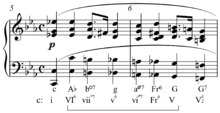Chromatic fourth

In
chromatic line). The quintessential example is in D minor
with the tonic and dominant notes as boundaries:
The chromatic fourth was first used in the
Well-Tempered Clavier
, for example (the chromatic fourth is indicated by the red notes):
![\relative c'{
\key d \minor
\times 2/3 {[d16 e f]} \times 2/3 {[g f e]} \times 2/3 {[f g a]} \times 2/3 {[bes a g]}
a8 \override NoteHead.color = #red d cis c b bes a \override NoteHead.color = #black g ~ g f e a
}](http://upload.wikimedia.org/score/m/h/mhmidvin6nz01yvqoa9szpmymnq8nhx/mhmidvin.png)
Beethoven's Ninth Symphony, the chromatic fourth appears in the cellos and basses. ⓘ
.This does not mean that the chromatic fourth was always used in a sorrowful or foreboding way, or that the boundaries should always be the tonic and dominant notes. One counterexample comes from the Minuet of
K.
387 (the chromatic fourths are conveniently bracketed by the slurs and set apart with note-to-note dynamics changes):

Musical works using the chromatic fourth or passus duriusculus

- Henry Purcell, "Dido's Lament"[2]
- Robert de Visée, Suite in C minor : Sarabande
- BWV 12, "Weinen, Klagen, Sorgen, Zagen"
- J. S. Bach, BWV 78: "Jesu, der du meine Seele"
- J. S. Bach, BWV 150: "Nach Dir, Herr, verlanget mich"(in the first choral, and a reverse, whole note upwards melody in the final Chaconne)
- Orgelbüchlein, BWV 614: "Das Alte Jahr vergangen ist" (in the three accompanying voices) ⓘ
- Invention No. 9 in F minor, BWV 795(second subject)
- J. S. Bach, Prelude and Fugue in C-sharp minor, BWV 849, second voice in bar 69, soprano in bar 71
- J. S. Bach, Prelude and Fugue in E minor, BWV 855, fugue subject
- J. S. Bach, Prelude and Fugue in A minor, BWV 889, Prelude subject
- J. S. Bach, Prelude and Fugue in E minor, BWV 548, the widening chromatic character of the fugue subject lends the work the subtitle "The Wedge".
- J. S. Bach, Toccata in E minor, BWV 914, fugue subject
- W. A. Mozart, K. 594: "Stück für ein Orgelwerk in einer Uhr"
- Ludwig van Beethoven, Symphony No. 9, ending of first movement
- Frédéric Chopin, No. 20 from 24 Preludes, Op. 28
- Hector Berlioz, Requiem, Op. 5
- César Franck, Prelude, Chorale and Fugue
References
- ISBN 978-0-07-310188-0.
- ^ ISBN 978-0-691-05716-3.
- ISBN 0-19-816563-3.
